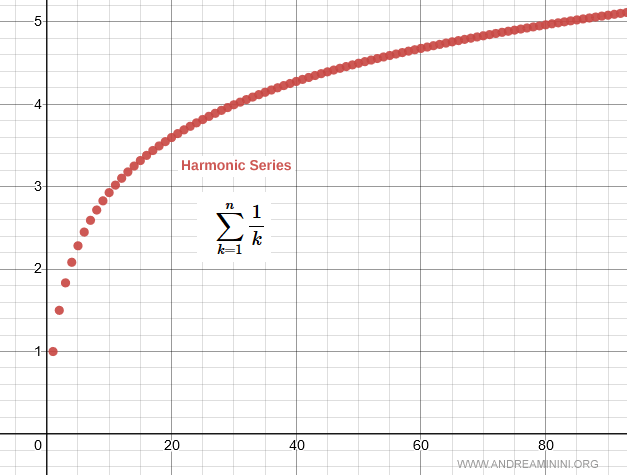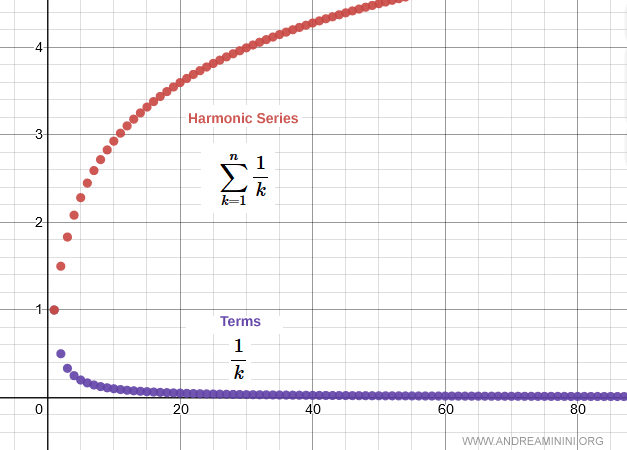Harmonic Series
This is known as the harmonic series: $$ \sum_{k=1}^{\infty} \frac{1}{k} = 1 + \frac{1}{2} + \frac{1}{3} + \frac{1}{4} + \frac{1}{5} + \dots $$
The harmonic series is the sum of the reciprocals of the natural numbers.
Despite its slow growth, the series diverges - a fact that may not be immediately obvious.
A Visual Example
The image below shows the partial sums of the harmonic series as $k$ increases.

Behavior of the Harmonic Series
The harmonic series diverges as $k \to \infty$.
The individual terms of the series tend to zero as $k \to \infty$:
$$ \lim_{k \rightarrow \infty} \frac{1}{k} = 0 $$
This satisfies the necessary condition for convergence of a series.
Note. While this condition is necessary, it is not sufficient for convergence. It’s a common pitfall to assume otherwise.
In fact, the harmonic series is a well-known example of a divergent series.

A Proof
To prove divergence, consider the sequence:
$$ a_k = \left(1 + \frac{1}{k} \right)^k $$
This sequence is increasing and converges to a well-known notable limit:
$$ \lim_{k \rightarrow \infty} \left(1 + \frac{1}{k} \right)^k = e $$
So, we can write:
$$ e \ge \left(1 + \frac{1}{k} \right)^k \quad \text{for all } k \in \mathbb{N} $$
Taking the natural logarithm of both sides yields:
$$ \log e \ge \log\left(1 + \frac{1}{k} \right)^k $$
Since $\log e = 1$, we obtain:
$$ 1 \ge k \cdot \log\left(1 + \frac{1}{k} \right) $$
Dividing both sides by $k$ gives:
$$ \frac{1}{k} \ge \log\left(1 + \frac{1}{k} \right) $$
Which is equivalent to:
$$ \frac{1}{k} \ge \log(k+1) - \log(k) $$
This tells us that each term of the harmonic series is greater than or equal to the corresponding term in the logarithmic difference sequence.
Summing both sides from $k = 1$ to $n$:
$$ \sum_{k=1}^{n} \frac{1}{k} \ge \sum_{k=1}^{n} \left[ \log(k+1) - \log(k) \right] $$
So the harmonic series is greater than or equal to a telescoping sum.

This sum simplifies to:
$$ \sum_{k=1}^{n} \left[ \log(k+1) - \log(k) \right] = \log(n+1) - \log(1) = \log(n+1) $$
Hence:
$$ \sum_{k=1}^{n} \frac{1}{k} \ge \log(n+1) $$
Explanation. This is a classic telescoping series: $$ (\log 2 - \log 1) + (\log 3 - \log 2) + \dots + (\log(n+1) - \log n) = \log(n+1) - \log 1 = \log(n+1) $$ 
Now, taking the limit as $n \to \infty$:
$$ \lim_{n \to \infty} \sum_{k=1}^{n} \frac{1}{k} \ge \lim_{n \to \infty} \log(n+1) = \infty $$
Which implies:
$$ \lim_{n \to \infty} \sum_{k=1}^{n} \frac{1}{k} = \infty $$
This confirms that the harmonic series diverges.
An Alternative Proof
Here’s another approach, based on integration.
For any $x \ge k$, we have:
$$ \frac{1}{x} \le \frac{1}{k} $$
Integrating both sides from $k$ to $k+1$:
$$ \int_k^{k+1} \frac{1}{x} \, dx \le \int_k^{k+1} \frac{1}{k} \, dx $$
Pulling the constant $1/k$ out of the second integral:
$$ \int_k^{k+1} \frac{1}{x} \, dx \le \frac{1}{k} \cdot \int_k^{k+1} dx = \frac{1}{k} $$
Summing from $k = 1$ to $n$ gives:
$$ \sum_{k=1}^n \int_k^{k+1} \frac{1}{x} \, dx \le \sum_{k=1}^n \frac{1}{k} $$
The left-hand side is the integral from 1 to $n+1$:
$$ \int_1^{n+1} \frac{1}{x} \, dx \le \sum_{k=1}^n \frac{1}{k} $$
Explanation. The sum $$ \sum_{k=1}^n \int_k^{k+1} \frac{1}{x} \, dx = \int_1^2 \frac{1}{x} \, dx + \int_2^3 \frac{1}{x} \, dx + \dots + \int_n^{n+1} \frac{1}{x} \, dx $$ represents the area under $1/x$ from $x = 1$ to $x = n+1$, which is $$ \int_1^{n+1} \frac{1}{x} \, dx $$
Evaluating the integral yields:
$$ \log(n+1) - \log(1) = \log(n+1) $$
So:
$$ \log(n+1) \le \sum_{k=1}^n \frac{1}{k} $$
Taking the limit as $n \to \infty$:
$$ \lim_{n \to \infty} \log(n+1) \le \lim_{n \to \infty} \sum_{k=1}^n \frac{1}{k} $$
Since the logarithmic term grows without bound, we conclude:
$$ \infty \le \lim_{n \to \infty} \sum_{k=1}^n \frac{1}{k} $$
By the comparison test, the harmonic series diverges.
And so, the divergence is fully established.
